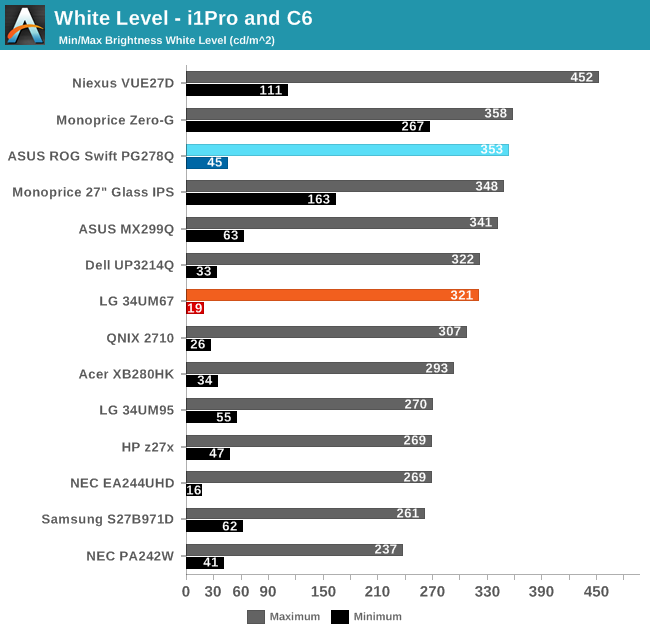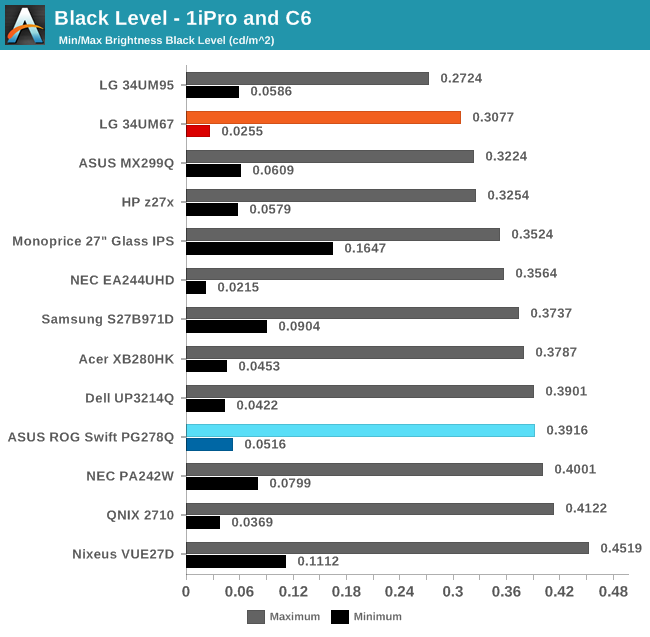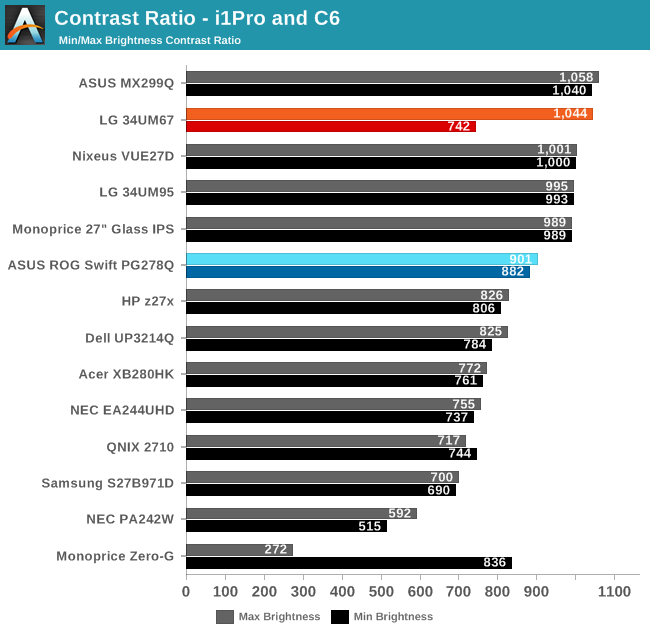LG 34UM67: UltraWide FreeSync Review
by Jarred Walton on March 31, 2015 3:00 PM ESTLG 34UM67 Brightness and Contrast
Moving on from the FreeSync discussion, we still need to see how the LG 34UM67 fares as a display. We’ve run our usual assessments to look at brightness, contrast, color accuracy, and uniformity. We’ll start with the brightness results. The LG FreeSync 34UM67 is in orange/red while we've highlighted the ASUS PG278Q in cyan/blue.

Set to maximum brightness with the default (50/50/50) RGB values, the 34UM67 can output 306 nits, which is just above the rated 300 nits. However, you can increase the output a bit more by maxing out the RGB values at 100, which gives us the above result of 321 cd/m2. This is plenty bright for most people, and more than I would normally need (outside of situations where the display needs to overcome reflections and lights during the day.) Setting the brightness to the minimum level with 50% RGB drops the display to 52 cd/m2, which is perhaps a bit too bright, but if you tweak RGB settings you can get as low as 19 cd/m2. That can work even in very dark rooms, so LG has covered all the necessary output range.

Black levels are okay but nothing amazing. At the maximum backlight (with the OSD Black Stabilizer set to 0 – increasing it will increase black levels somewhat, ostensibly to help you see dark areas in games better), we measured 0.3077 cd/m2. Going to the minimum backlight level this falls down to 0.0255 cd/m2. Interestingly, LG doesn’t appear to be using any form of dynamic contrast, so whether we test with a full screen color or 50% APL patterns makes no difference. That’s a good thing if you’re wondering, as dynamic contrast often ends up being more of a distraction than a benefit (IMO).

The resulting contrast ratios range from just over 1000:1 to closer to 750:1, but the contrast ratio stays pretty consistent until the very lowest brightness settings. Also note that our i1 Pro meter isn’t the most accurate sensor for black levels, so that might contribute to some of the difference. Overall, the contrast ratio is good but not exceptional.










96 Comments
View All Comments
xthetenth - Wednesday, April 1, 2015 - link
For working purposes I would not consider a 16:x 4k an upgrade from 3440x1440 at all. I would be trading sufficient x space to have a third item up or a wide item and a narrow one up at the same time in return for a small amount of y space that doesn't make a meaningful difference. Past roughly 1200 pixels tall, 21:9 is by far the best aspect ratio for work. By 1200 pixels, there's plenty of y space that added information by increasing y space is facing seriously diminishing returns, while x space is starting to go from two pretty wide windows to three windows side by side, which is still giving significant returns.Of the current selection of monitors, I would definitely choose 3440x1440 to keep for 5 years, and spending that much tends to come with a very nice, calibrated screen. A $300-$400 2560x1440 isn't the same quality screen.
wweeii - Tuesday, March 31, 2015 - link
Theoretically even if you drop below 48hz it shouldn't be all bad.Between 16 and 24 fps, you can just triple the refresh rate, 48-75hz would work just fine without tearing.
Between 24 and 37 fps, you double the refresh rate, so no problem either.
You would only have a problem between 37 to 48 FPS, which is unfortunate.
Soulwager - Tuesday, March 31, 2015 - link
But AMD isn't doing that, and the VRR window is too small to do window shifting. If you want to display every frame on time you need a max frame interval needs to be greater than your frametime variance plus double the minimum frame interval.Soulwager - Tuesday, March 31, 2015 - link
You can test input lag with inexpensive hardware, for example, an arduino with native USB that emulates a mouse input and measures a subsequent brightness change with a photoresistor.Ryan Smith - Tuesday, March 31, 2015 - link
If you could, please shoot me an email.Soulwager - Tuesday, March 31, 2015 - link
Done.OrphanageExplosion - Wednesday, April 1, 2015 - link
Is there a link with an explanation for this somewhere so we can all take a look at this idea?Soulwager - Thursday, April 2, 2015 - link
Yes, here's a forum post: http://forums.blurbusters.com/viewtopic.php?f=10&a...jjj - Tuesday, March 31, 2015 - link
This gave me an idea, a Cypress PSoC board instead of Arduino could also work and maybe you could make a similar device to test touch responsiveness in phones and tabs. Cypress makes touch controllers so maybe they would help you out with some coding to enable you to test touch responsiveness. You could at least try. Guess Arduino started with Atmel chips and Atmel is also one of the major touch controller players so you could try to ask for their help too.cbrownx88 - Tuesday, March 31, 2015 - link
Yes - please email him! lol